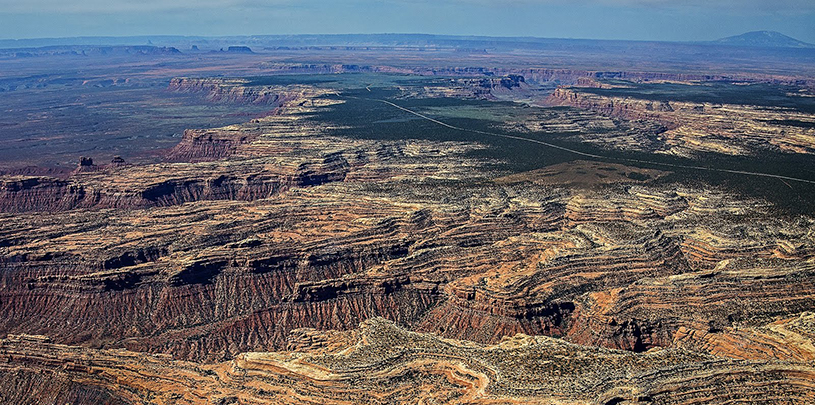
 by Tim Peterson, Utah Wildlands Director
by Tim Peterson, Utah Wildlands Director
A “discussion draft” of the Public Lands Initiative (PLI) released January 20, 2016, falls far short of the ambitious goal set forth by Congressman Rob Bishop (R, UT) in 2013 – “to build consensus among stakeholders” over which areas in seven eastern Utah counties should be preserved and which should be developed. Because the PLI would weaken existing on-the-ground protections for irreplaceable cultural resources and much of eastern Utah's best wilderness-quality lands, the Grand Canyon Trust cannot and does not support this draft of the legislation.
After months of delay, the discussion draft of the PLI represents the most cynical attempt at a “grand bargain” in the history of the Colorado Plateau. Though the draft purports to offer wilderness protection for more than two million acres of public lands, it’s littered with dead-on-arrival provisions, such as:
No protection for millions of acres of deserving wilderness
The PLI overlooks millions of acres of iconic Colorado Plateau landscapes. Many of these deserving areas never be managed to protect wilderness character or be considered for wilderness protection again.
A new kind of “wilderness”
The PLI allows motorized vehicle use in wilderness to “rescue sick animals” or for the “placement of feed” for livestock. It also allows aerial gunning of predators in wilderness and new water development facilities.
Protection in name only
The PLI creates National Conservation Areas where motorized recreation is a primary purpose and management to protect wilderness character and future congressional wilderness designation is permanently prohibited.
The Bears Ears cultural landscape is not adequately protected
The PLI offers no protection for vast areas containing important cultural resources and sacred sites. It promotes state and local control, and diminishes the legitimate voice of sovereign tribal nations to influence management.
A climate disaster
The PLI creates “energy zones” where fossil fuel extraction is prioritized above all other uses on public lands.
Reckless livestock grazing
The PLI recklessly locks in or increases livestock numbers in all new wilderness, national conservation, and special management areas, regardless of drought, market conditions, or ecological damage.
Public lands giveaway
The PLI hands lands from the United States to counties and the State of Utah absolutely free – in one case to build an off-road vehicle play park atop irreplaceable cultural resources.
Thousands of “road” claims
The PLI gives lands over to state and county ownership with no surveys for cultural resource damage.
New “Hydrocarbon Highway”
The PLI opens new markets for the world’s dirtiest fossil fuels by granting title to the State of Utah for a fossil fuel haul road connecting the Uintah Basin south to Interstate 70 through Utah’s wild Book Cliffs.
Exchange of state lands within newly protected areas
U.S. taxpayers are fleeced. Valuable federal lands are given to the state, while the federal government receives a smaller acreage of state lands of lesser value in return. Land valuation is not required.
Ability of a president to designate new national monuments
Likely banned forever. Though not present in this draft for fear of controversy, a blank space for this action waits to be filled in when the bill enters legislative markup.
Read more of the Trust's official comments on the PLI ›
In creating the PLI, Representative Rob Bishop embarked on an ambitious journey with the stated goal of breaking the stalemate over permanent land protection in eastern Utah. He wrote of a “window of opportunity” and “a paradigm shift,” and of “moving away from the tired arguments of the past,” promising that “a more reasonable, balanced use of the public land can be achieved in Utah.” It seemed as if a new day had dawned, and all sides of the contentious public lands debate searched and stretched themselves to envision concessions and compromise none of us had previously thought possible.
Throughout 2013 and 2014, we made solid progress. We reached negotiated agreements with all parties in two counties, striking a delicate balance that ensured conservation came out ahead. Things began to sour in 2015, as the congressional delegation allowed one county to break from our negotiated agreement. Another county excluded everyone living outside the county in crafting their proposal and entirely dismissed local concerns by rejecting a home-grown proposal to fully protect the Bears Ears cultural landscape—one that garnered 64 percent of local support. Other counties retreated to the “tired arguments of the past,” and discussions deteriorated over too little wilderness and too much fossil fuel development. Despite our best efforts toward reaching durable compromise over dozens of field trips and mapping work sessions, it is clear that no “paradigm shift” has taken place.
To say the draft PLI is a disappointment would be a dramatic understatement. Nonetheless, the Trust remains hopeful that all sides can find the political will to begin again in a subset of counties where consensus among stakeholders is within reach, renewing the hope and optimism that characterized the origins of the PLI.
Though consensus compromise has thus far failed through the PLI, we know that win-win solutions are possible—solutions which truly serve the best interests of future generations and Utah’s exceptional landscapes. For now, it seems our best and only option is to continue offering our unreserved support to the Bears Ears Intertribal Coalition in their push for a new presidentially-proclaimed national monument. We are tremendously excited about Bears Ears, and we hope you are too.
As 2024 draws to a close, we look back at five maps we created this year that give us hope for 2025.
Read MoreA small victory in the legal case challenging Daneros uranium mine, near Bears Ears National Monument.
Read MoreMugs, handmade soaps, high fashion, jewelry and more. There's something for everyone on your holiday shopping list.
Read More